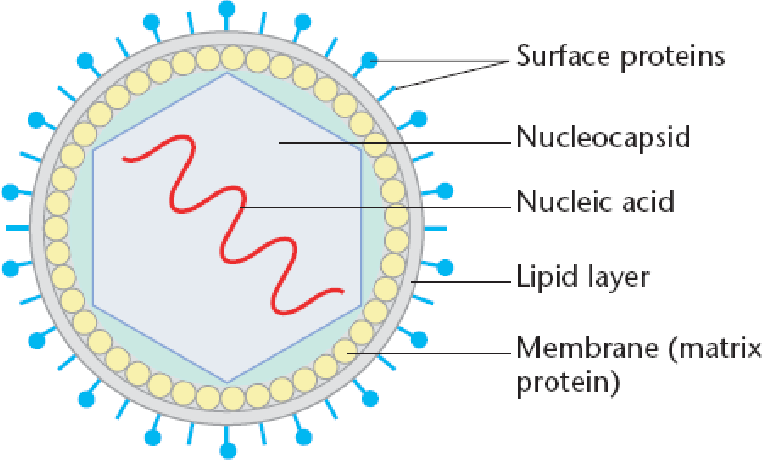
The viruses are known as
A. Unicellular
B. Acellular
C. Multicellular
D. Free genes
Answer
518.4k+ views
1 likes
Hint: A virus is made up of a DNA or RNA genome inside a protein shell called a capsid. Some viruses have an external membrane envelope.
Complete answer: A virus is composed of a nucleus of genetic material, either DNA or RNA, surrounded by a protective surface called a protein-composed capsid. Often an extra spikey coat called the envelope covers the capsid. Viruses are capable of latching on and moving inside host cells.
When the freshly formed viral particle brushes against the plasma membrane of the host cell a portion of it adheres. The plasma membrane envelops the virus and forms the underlying cell. The virus discharges from the cell. This cycle uses up the cell membrane of the host gradually and typically leads to the death of cells.

Fig. Virus
Particles of the virus break out into the extracellular space from the host cell, resulting in the host cell death. Once the virus has left the host cell it is free to enter and spread into a new cell.
So, the option (D) is correct
Note: Viruses are widely diverse. We come in various shapes and architectures, we have various genomes and they infect different hosts.
Viruses replicate by infecting their host cells and reprogramming them into "factories" which create viruses.
Complete answer: A virus is composed of a nucleus of genetic material, either DNA or RNA, surrounded by a protective surface called a protein-composed capsid. Often an extra spikey coat called the envelope covers the capsid. Viruses are capable of latching on and moving inside host cells.
When the freshly formed viral particle brushes against the plasma membrane of the host cell a portion of it adheres. The plasma membrane envelops the virus and forms the underlying cell. The virus discharges from the cell. This cycle uses up the cell membrane of the host gradually and typically leads to the death of cells.

Fig. Virus
Particles of the virus break out into the extracellular space from the host cell, resulting in the host cell death. Once the virus has left the host cell it is free to enter and spread into a new cell.
So, the option (D) is correct
Note: Viruses are widely diverse. We come in various shapes and architectures, we have various genomes and they infect different hosts.
Viruses replicate by infecting their host cells and reprogramming them into "factories" which create viruses.
Latest Vedantu courses for you
Grade 11 Science PCM | CBSE | SCHOOL | English
CBSE (2025-26)
School Full course for CBSE students
₹41,848 per year
Recently Updated Pages
Master Class 12 Economics: Engaging Questions & Answers for Success

Master Class 12 Maths: Engaging Questions & Answers for Success

Master Class 12 Biology: Engaging Questions & Answers for Success

Master Class 12 Physics: Engaging Questions & Answers for Success

Master Class 12 Business Studies: Engaging Questions & Answers for Success

Master Class 12 English: Engaging Questions & Answers for Success

Trending doubts
Which one is a true fish A Jellyfish B Starfish C Dogfish class 10 biology CBSE

The Equation xxx + 2 is Satisfied when x is Equal to Class 10 Maths

Why is there a time difference of about 5 hours between class 10 social science CBSE

Fill the blanks with proper collective nouns 1 A of class 10 english CBSE

When and how did Canada eventually gain its independence class 10 social science CBSE

What is the median of the first 10 natural numbers class 10 maths CBSE




